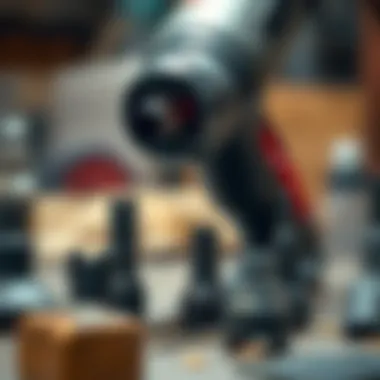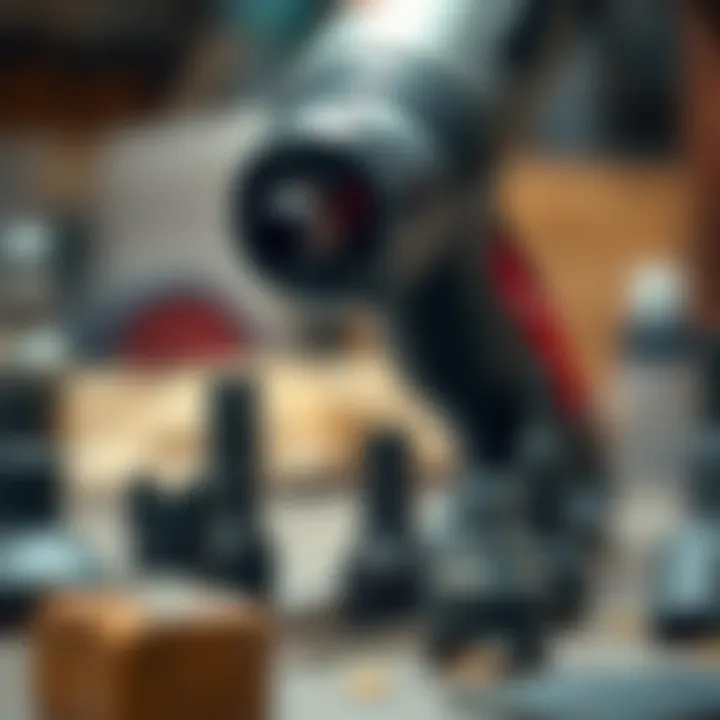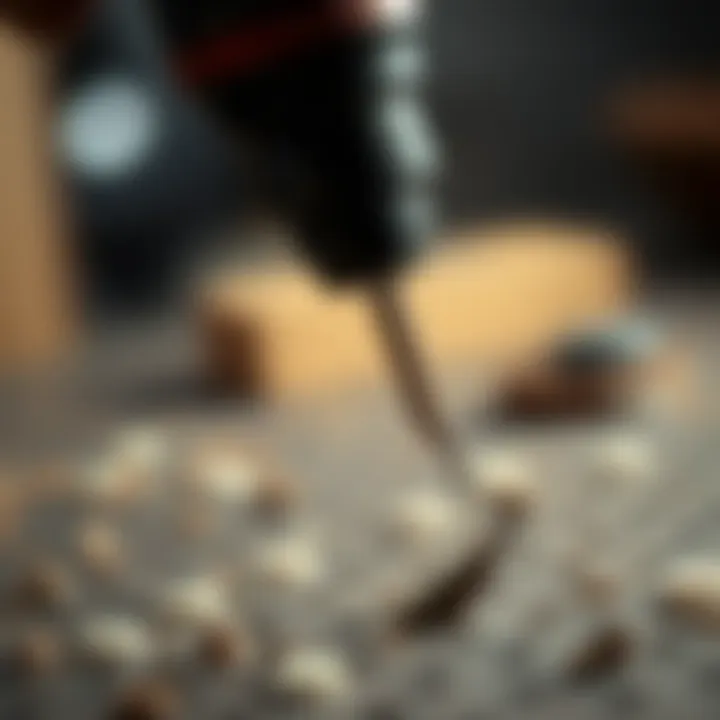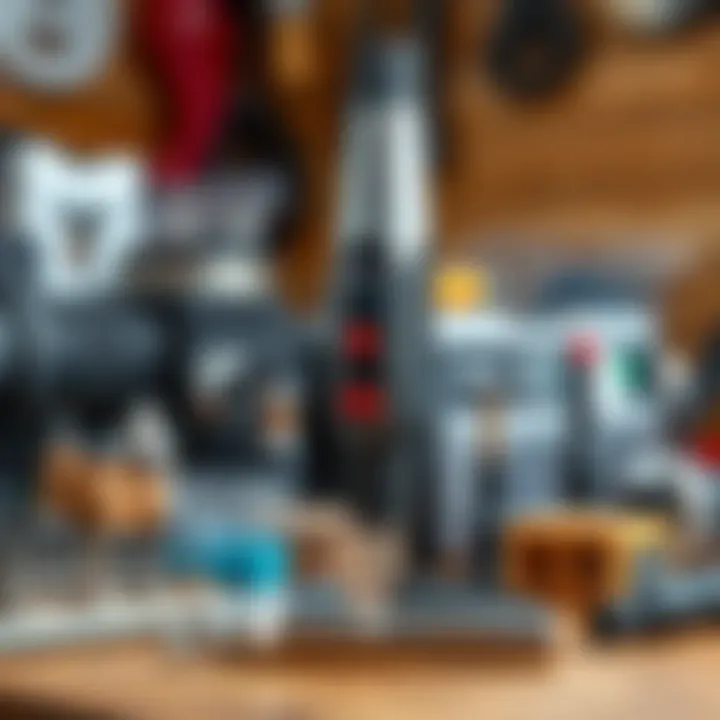Essential Guide to Dremel Tools for Beginners


Intro
For anyone venturing into the world of crafting, particularly with collectibles like rocks and fossils, the Dremel tool can be a game changer. This compact rotary tool stands out not just for its versatility but also for its precision, fitting the needs of newbies who are starting small yet dreaming big. In this guide, you’ll discover the essential components of the Dremel tool, practical applications it can tackle, and how to maintain it over time to ensure its long-term usability.
Before diving into specifics, understanding the importance of this tool in the realm of hobbies, especially for collectors, is key. Being able to work on various materials—whether you’re polishing a rare specimen of quartz or engraving intricate designs on fossils—opens up a whole new range of possibilities. Let's explore the history and origins of the Dremel tool as well as its significance in the collectibles community.
Understanding the Dremel Tool
When it comes to tackling small projects or intricate detailing, a Dremel tool can be a game-changer, particularly for hobbyists and collectors. Understanding the Dremel tool not only brings clarity around its applications and benefits but also helps novices harness its potential effectively. In this section, we will delve into the fundamental aspects of Dremel tools, paving the way for readers to make informed decisions and elevate their skills.
Definition and Purpose
A Dremel tool is essentially a versatile rotary tool that can be used for various tasks, ranging from cutting and sanding to engraving and polishing. This tool is favored for its ability to execute delicate work with precision that larger tools simply cannot achieve. Specifically, for rock and fossil enthusiasts, the Dremel is ideal for shaping stones and creating fine details on specimens without overdoing it—allowing for the preservation of delicate structures.
Types of Dremel Tools
Choosing the right model is the first step in utilizing the capabilities of a Dremel tool. Here, we break down the types available to help beginners navigate through their options.
Corded Models
Corded Dremel models are known for their continuous power supply. When you plug them in, you unleash robust performance without worrying about battery life. This is particularly beneficial for extended projects, which can often be the case when working on fossil displays or intricate rock cuts. The key characteristic of corded models is their reliable torque, favoring users who need constant operational energy. However, mobility might be limited as they tether you to an outlet, which could be a drawback in certain setups.
Cordless Models
On the other hand, cordless Dremel tools offer unparalleled convenience. With built-in batteries, they allow artists and collectors to work freely without the constraints of wires. This aspect is particularly appealing when working outdoors or in various corners of a workshop. Cordless models tend to be lighter, making them easy to maneuver for prolonged periods. That said, be prepared to fully charge them beforehand, as diminishing battery life can interrupt the workflow when least expected.
Specialized Models
For those looking to focus on specific tasks, specialized Dremel models cater to niche needs such as carving, woodwork, or engraving. Clearly designed with unique functionalities, these models provide precision tailored for dedicated crafts. Their advantages lie in being purpose-built, often presenting unique attachments that enhance performance for that specific task. Alternatives include multi-tools with various attachments, making them a versatile choice for beginners wanting to experiment across different applications. However, they might come at a premium price compared to standard models.
Key Features and Specifications
Understanding the specifications of the Dremel is equally as crucial as knowing its types. Different features can significantly impact your experience and results when using the tool.
Speed Settings
Speed settings are a compelling feature of Dremel tools, allowing users to adjust the rotational velocity based on their tasks. Beginners will find this particularly beneficial, as it provides a learning curve; starting slowly and gradually increasing speed based on comfort. Higher speed settings can be effective for cutting through harder materials, while slower settings lend control when polishing delicate surfaces. Proper use of speed settings can result in cleaner finishes and reduced risk of tool damage.
Power Rating
The power rating of a Dremel tool determines its efficiency and cutting abilities. A higher power rating often translates to better performance in tougher materials, making it essential for beginners to consider their intended projects before purchasing. Most models fall between 120 to 175 watts; more power typically benefits larger or more demanding projects, especially when shaping rock collections. However, more power means more weight, and beginners must balance their need for strong performance against comfort and control.
Size and Weight
The size and weight of a Dremel tool contribute significantly to its user-friendliness. Lightweight models are ideal for beginners, as they minimize fatigue during prolonged use. The compact design allows for precision work, particularly when tackling detailed projects on fossils or delicate rock artefacts. That said, larger tools might offer added stability and power, albeit at the cost of portability and ease of handling.
Ultimately, the Dremel tool is all about finding the right balance between power, control, and usability to meet your unique crafting needs.
Essential Accessories
When diving into the world of Dremel tools, understanding the role of essential accessories cannot be overstated. These components enhance the tool's capabilities, allowing users to tackle a broader range of tasks more effectively. For beginners, the right accessories can be the difference between a successful project and one that leaves frustration in its wake. Considerations such as compatibility, quality, and intended use are paramount in selecting these accessories.
Common Attachments
Cutting Discs
Cutting discs play a pivotal role in the Dremel toolkit, acting as the go-to attachment for slicing through various materials. Their thin, flat profile makes them particularly effective for delicate cuts, whether you're working on rocks, wood, or even metal. The key characteristic of these discs is their ability to make precise cuts without causing significant damage to the surrounding material, which is invaluable for collectors of fossils. A notable feature of cutting discs is their versatility; they can be used for straight cuts or even intricate details, depending on the skill of the user.
However, one must be cautious. While they’re a beneficial choice due to their precision, improper use can lead to wear or breakage. Get to know the material you're cutting and the recommended speed settings, because overheating can render these discs ineffective quite quickly, which is a hassle.
Sanding Bands
Sanding bands are another essential accessory that holds significant value for Dremel users, especially those working on detailed finishes. These bands, often made from abrasive materials, can smooth out rough edges, shape wood or soften sharp surfaces. Their rounded design allows them to fit snugly onto various bits, providing a comfortable grip that aids in control.
A key characteristic that makes sanding bands popular is their ability to conform to the shape of the material being worked on. This adaptability helps achieve a finish that's both consistent and aesthetically pleasing. A practical side of sanding bands is their replaceable nature; as they wear down over time, they can be effortlessly swapped out for a fresh band, ensuring your projects stay on track.
Yet, there's a bit of a drawback; they may not be as effective on harder materials like metals, which might require more robust sanding solutions. So, choose appropriately based on your project’s needs.
Polishing Wheels
Polishing wheels can be likened to the cherry on top of your Dremel accessory needs. Designed to refine and add luster to materials, these wheels are particularly beneficial when working with softer stones or metals, perfect for rock and fossil enthusiasts. The vital characteristic here is the fine, soft material from which these wheels are made, providing a superb finish without scratching delicate surfaces.
What makes polishing wheels uniquely beneficial is their ability to deliver a high-gloss finish that transforms basic pieces into showstoppers. However, while they are fantastic for achieving that final shine, they also require the right type of polishing compound to maximize effectiveness. Without it, results can be lackluster, leaving collectors yearning for that flawless look they desire.
Choosing the Right Bit


Selecting the correct bit is crucial when working with Dremel tools. The bit determines what kind of tasks can be accomplished, be it cutting, engraving, or polishing. Each bit is designed for specific material types, and understanding these differences can considerably improve your project outcomes. For instance, carbide bits work excellently with metals, while diamond bits are ideal for harder stones. Remember to consider the material and desired finish before making your pick to avoid frustration down the line.
Storage Solutions for Accessories
With a diverse array of accessories, proper storage becomes essential. A well-organized setup allows easy access to your materials, making the integrated use of your Dremel tool more fluid and enjoyable. Consider investing in magnetized tool holders, clear bins, or even customized toolboxes that keep everything neatly segregated. This not only prevents loss of components but also accelerates your project work, allowing you to find what you need when you need it.
Understanding Safety Practices
When it comes to using a Dremel tool, prioritizing safety is non-negotiable. These devices can be incredibly versatile and effective for a range of projects, especially for enthusiasts dealing with delicate collectibles like rocks and fossils. Yet, without proper safety precautions, one can quickly find themselves in a precarious situation. Safety practices guide users to protect themselves against physical injuries and health risks, ensuring a more enjoyable crafting experience. Let's delve into personal protective equipment, creating a safe work environment, and identifying hazards to steer clear of.
Personal Protective Equipment
Safety Goggles
Safety goggles are not merely an accessory; they are a fundamental part of working with a Dremel tool. The primary benefit of goggles lies in their ability to shield your eyes from flying debris and dust that may arise during cutting, sanding, or engraving. A notable characteristic of safety goggles is their snug fit, ensuring that no particles can circumvent protection. This is particularly crucial for rock and fossil collectors, as tiny pieces can become airborne when chiseling through dense materials.
Consider goggles that meet ANSI Z87.1 standards for optical clarity and impact resistance. They often come with anti-fog features, an advantage when you’re working up a sweat. However, some folks find them a bit cumbersome, especially if they are not adjustable. But taking the time to choose a good pair can save your eyesight from potential mishaps.
Dust Masks
In a hobby where dust and fine particles are second nature, wearing a dust mask can’t be overlooked. Dust masks serve an essential function by filtering out negative particles and preventing respiratory problems that stem from prolonged exposure to silica and other harmful dust particles. Many opt for disposable masks rated N95 or higher, which effectively reduce inhalation of dust and allergens.
What sets apart a good dust mask is the comfortable fit and breathability. Cheaper masks might allow particles to slip through or could become uncomfortable during long projects. In choosing to invest in a quality mask, collectors can safeguard their lungs during dusty tasks.
Gloves
Gloves are another piece of the safety puzzle. Specifically, they offer an added layer of protection against cuts and abrasions, making them a beneficial choice for all types of Dremel projects. Look for gloves made of durable materials that still allow enough dexterity for precision work—some craftsmen even prefer fingerless designs for heightened control on delicate tasks like fossil restoration.
It's crucial to pick gloves that fit well; ill-fitting gloves can lead to mishaps or decreased grip on tools. On the downside, wearing gloves can create a false sense of security, leading some users to neglect caution when handling sharp bits and tools. As with all equipment choices, the emphasis should be on the right type of glove for the job at hand.
Setting Up a Safe Work Environment
Creating a safe workspace is essential and, frankly, a reflection of your preparation level. Start by ensuring that your workspace is clean and organized, thereby reducing the chances of accidents. A cluttered table is an invitation for trouble. Ensure there is enough space to maneuver without bumping into things or stepping on stray bits.
It's good practice to have adequate lighting, illuminating your work area and allowing you to see the subtle details of your projects. Additionally, consider the noise level—some Dremel tools can be quite loud, so it's advisable to use them in an area away from noise-sensitive environments or invest in ear protection.
Common Hazards to Avoid
Understanding what to avoid in your workshop can save you from unwanted surprises. One common hazard is neglecting to secure your workpiece properly. Always use clamps or vises to keep your materials in place; hands and fingers can easily end up in the wrong spot.
Moreover, never overlook the importance of letting the tool cool down before handling it. Overheating can not only degrade the tool but could also lead to burns. Ventilation is another critical concern. Using your Dremel in a closed-off area can increase the risk of inhaling toxic particles or fumes. Make sure you have good airflow to dissipate any harmful substances created during operation.
Safety should be interwoven into every aspect of using the Dremel. By arming yourself with knowledge and the right gear, the path to creating masterpieces in your crafting endeavors becomes a safer and more enjoyable journey.
Basic Techniques for Beginners
Understanding fundamental techniques is crucial for anyone looking to use a Dremel tool effectively. Mastering these basic skills not only enhances your proficiency but also ensures that your projects turn out as envisioned. For a beginner, these techniques serve as a stepping stone into a world where creativity meets precision.
Drilling
Drilling with a Dremel can be a game-changer for various projects, especially when working with different materials, including wood, plastics, and even metals. The versatility offered by a Dremel compared to traditional drills is noteworthy. When drilling, selecting the right bit is vital; usually, a small high-speed steel bit works best.
Drilling allows for intricate designs and is immensely helpful for rock and fossil collectors wanting to create displays or prepare mounting holes. It’s key to maintain a steady hand, applying consistent pressure without forcing the tool; this helps you avoid any unwanted breakage or chipping of the material.
- Start Slow: Begin with lower speeds to avoid overheating or damaging the material.
- Use a Guide: For more precise holes, use a clamp or a guide to stabilize your workpiece.
- Positioning Matters: Keep the drill bit perpendicular to your work surface for a straight hole.
[Beginner tip: Practice on scrap material first to build confidence and technique.]
Sanding
Sanding can transform rough edges into smooth finishes, a must-have skill for crafting polished look in your projects. The Dremel’s sanding bits are designed for specific tasks—some are for larger surfaces, while others work wonders on intricate details.
- Select the Right Grit: Start with a coarser grit and gradually progress to a finer one. This way, you effectively remove material while smoothing the surface.
- Watch Your Angles: Tilting the Dremel at the right angle is vital; too steep may damage your material, while too shallow might be ineffective.
- Keep it Moving: Don’t stay in one place for too long; it can create uneven surfaces or gouges.
Engaging in sanding techniques can be particularly rewarding when you want to enhance the appearance of raw fossils and rocks, allowing their natural beauty to shine.
Cutting
Cutting with a Dremel is one of the primary functions and a popular choice for many collectors and crafters alike. This tool's ability to cut through various materials expands your capabilities significantly. Whether you're slicing through plastic to create a custom display or carefully trimming a delicate rock, precision is key.
For effective cutting, here are a few pointers:
- Choose the Right Attachment: Cutting wheels are your go-to, but ensure you select one suitable for the material.
- Steady Hands: Like drilling, maintaining control is essential to achieve clean cuts without cracks or splintering.
- Cooling Technique: If you're cutting through thicker materials, consider periodic pauses to let the tool and material cool down.
Practice on waste material to hone this skill before cutting valuable pieces.
Engraving


Engraving is where artistry meets functionality, particularly appealing to those looking to personalize their items. The Dremel tool makes it easy to etch patterns onto stones or engrave your name on tools. Selecting an engraving bit is crucial; finer bits are suitable for detailed work while larger bits are ideal for bolder designs.
When laying down your engraving:
- Plan Your Design: It can help to draw out your design beforehand. Sketching light pencil lines can guide you as you engrave.
- Slow and Steady: Slow, consistent movement ensures better control and more precise lines.
- Depth Control: Adjusting the pressure applied during engraving can create varying depths, adding character to your work.
With time and practice, you can transform ordinary items into personal masterpieces that truly reflect your identity and interests.
These basic techniques will form a solid foundation for your journey with the Dremel tool, opening doors to countless creative possibilities. As you familiarize yourself with these skills, you'll gain confidence and might even discover new projects that pique your interest.
Project Ideas for Beginners
Exploring the diverse possibilities that a Dremel tool offers can truly ignite creativity, especially for beginners looking to dabble in rock and fossil collecting. Whether it's crafting, displaying, or organizing, the right project ideas can transform simple tasks into engaging, educational experiences. This section sheds light on practical project ideas that harness the Dremel tool’s versatility while providing tangible benefits.
Collecting and Preparing Rocks
For many, the journey into the world of rock and fossil collecting begins with the thrill of the hunt. Enhancing this hobby with the Dremel tool opens doors to new techniques in preparing and preserving your finds.
Using a Dremel, collectors can meticulously clean rocks, removing unwanted dirt and residue. This not only improves the rock’s aesthetic but also prepares it for polishing—a crucial step in showcasing the rock's natural beauty. It's essential to select the right accessories, such as polishing wheels or brushing bits, to effectively clean various types of stones.
Emphasizing this process, consider integrating a few steps:
- Choose the right rock: Look for interesting shapes or textures that catch your eye.
- Initial cleaning: Rinse the rock to remove loose dirt.
- Use the Dremel tool: Position the rock securely and gently clean the surface using appropriate attachments.
- Final polishing: Use sanding bands followed by polishing wheels for a gleaming finish.
"The art of preparing rocks not only enhances their appearance but also raises the value among fellow collectors."
Crafting Customized Fossil Displays
Once you've gathered stunning fossils, how you present them can make all the difference. A Dremel tool can assist in crafting personalized displays that elevate your collectibles from mere items to conversation starters.
Start with a basic idea of what your display will look like. You might consider:
- Wooden bases: Cut and shape natural wood pieces to hold your fossils. Utilizing the cutting attachment gets you even and intricate shapes.
- Engraved labels: Add a personal touch by engraving names or dates on plaques using a Dremel engraver bit. This gives your display a professional edge and preserves the story behind your finds.
- Creative layouts: Don’t hesitate to mix and match various fossils. The Dremel allows for adaptability, helping craft and arrange various elements to create a visually appealing display.
Creating Personalized Tools and Holders
To make the most out of your Dremel tool experience, personalizing some of your tools and storage solutions can be a rewarding project. This not only enhances functionality but can also inspire organizational creativity.
Some ideas to consider include:
- Tool holders: Use the Dremel to carve out a dedicated holder for your bits and attachments. A simple wooden box can be drilled and shaped to snugly fit your tools.
- Customized grips: If you find your Dremel handle uncomfortable during prolonged use, consider using the tool to modify it. You can grind down certain areas for a better grip or even add personal designs.
- Workspace arrangements: As you dabble in projects, customizing your workspace is vital. Use the Dremel to create or enhance storage as you see fit, giving you easy access to everything when you need it.
Culmination
Project ideas for beginners not only pave the way for hands-on learning but also instill confidence in using the Dremel tool. Whether sprucing up your rock collection, building attractive displays, or creating tailored organizational solutions, each project serves as an important stepping stone toward mastery. Engaging with your hobby through these practical applications opens new doors, encouraging further exploration and creativity in the world of rock and fossil collecting.
Maintenance and Care
Proper maintenance and care of your Dremel tool not only extends its lifespan but ensures peak performance during each use. For beginners, it’s essential to grasp the basics of maintaining your equipment, especially if you plan to use it for intricate projects like working on collectibles such as rocks and fossils.
Taking a little time after each session to clean and check your tool can save you a lot of hassle down the line. It helps in avoiding unexpected issues when you’re elbow-deep in a creative project. Remember, a well-kept tool is not just good for your projects; it’s a way of showing respect to the craft.
Cleaning and Lubrication
Cleaning your Dremel tool does not need to be a chore. The more often you do it, the easier it becomes. After each use, wipe down the tool and its components with a soft cloth to prevent dust and debris from accumulating. Especially when working with dusty materials like rocks and fossils, you’ll want to keep everything spick and span to ensure that your tool operates smoothly.
When it comes to lubrication, it’s as simple as applying a few drops of light machine oil to the shaft of the tool. This helps reduce friction, especially with the bearings. Too much friction can cause overheating, which ain’t good for the longevity of your tool. Just think of it like giving your Dremel a refreshing drink—it keeps things moving seamlessly.
Here’s a quick checklist for cleaning and lubricating your Dremel:
- Unplug the tool before you start.
- Wipe down the exterior with a microfibre cloth.
- Use a brush to clear out any debris from vents and openings.
- For lubrication, apply a few drops of oil on the bearings.
- Inspect the casing for any signs of cracks or damages.
Checking and Replacing Accessories
Accessories are the heart and soul of your Dremel tool's versatility. Each one serves a specific purpose, and knowing when to replace them is crucial for maintaining efficiency in your projects. Ignoring worn-out accessories can compromise both your safety and the quality of your work.
Before diving into any project, take a moment to inspect your bits and attachments. Look for signs of wear, such as dull blades or damaged sanding bands. If you’re noticing that your tool is requiring more effort than usual, this could be a tell-tale sign that something’s amiss.
Here are some tips for checking and replacing accessories effectively:
- Visual Inspection: Check for any cracks or bends in your bits or attachments.
- Performance Test: If an accessory isn’t cutting or grinding efficiently, it might need replacing.
- Compatibility Check: Ensure you are using the right accessory for your specific project.
Replacing accessories does not require rocket science, just a little know-how. Most attachments can be easily swapped out, allowing you to switch functions with ease. This ability not only enhances your efficiency but also allows for more creativity as you tackle various projects.
In addition, online communities like Reddit and videos on platforms such as YouTube can provide wonderful insights on maintaining your Dremel tool and making appropriate accessory choices.
“A little extra care today can transform your workspace tomorrow.”


By paying attention to maintenance tasks like cleaning and checking accessories, you’ll be setting yourself up not just for success, but also enjoying the full range of functions that your Dremel tool can offer.
Collecting rocks or crafting items from fossils becomes a lot easier with a well-maintained tool. Keep going and maintain the care for your Dremel—your future creative self will thank you!
Troubleshooting Common Issues
Understanding how to troubleshoot common issues with a Dremel tool can save novice users a mountain of frustration. Whether you’re new to the world of tool usage or an experienced craftsman facing unexpected hurdles, knowing what might go wrong and how to fix it is invaluable. This section aims to equip rock and fossil collectors with the knowledge to handle common dilemmas effectively. A smoother project experience not only boosts confidence but also encourages creativity.
Assessing Performance Problems
When you start using your Dremel tool, it’s important to pay attention to how it performs. If the tool behaves unexpectedly, it could be a sign of a problem. There are a few indicators that your tool might be in need of attention. For instance, if you notice that it’s not cutting or sanding as effectively as before, it might be worth checking a few things:
- Inspect the Bits: Dull or damaged bits can cause poor performance. Check that your attachment is not worn out. Replacement is often the way to go.
- Look for Obstructions: Sometimes debris can get lodged in the tool, affecting how it operates. Make sure that the workspace is clean and free of any clutter.
When assessing performance, listen closely. Unusual sounds or vibrations can provide clues about what’s going awry. If everything seems okay, but the performance is still lacking, it might be time to seek more in-depth fixes.
Dealing with Overheating
Overheating is another common issue that can occur when using a Dremel tool. It can lead to not only a damaged tool but also potential injury. If your tool begins to feel excessively hot to the touch, it’s crucial to take action immediately. Here’s what you can do:
- Take Breaks: Allow the tool to cool down periodically, especially when undertaking large projects. A little patience pays off in the long run.
- Proper Speed Settings: Ensure that you’re using the appropriate speed setting for the task at hand. High speeds may be helpful for some tasks but can lead to overheating in others.
- Ventilation: Make sure you’re working in a well-ventilated area. Lack of airflow can exacerbate heat issues. If you’re indoors, consider opening a window or using a fan.
If overheating persists, this could indicate a more serious underlying problem with the tool’s motor. In such cases, consulting with a technician is advisable. Keeping an eye on heat can extend the life of your tool, allowing you to get the most out of every project.
Remember, maintaining your Dremel tool is as important as utilizing it. Well-cared tools perform better and last longer.
Resources for Continued Learning
Continued learning is crucial for harnessing the full potential of a Dremel tool, especially for novices delving into crafting or collecting. The world of Dremel and its applications is vast and constantly evolving, making it essential to stay updated on new techniques, accessories, and safety practices. This journey of learning doesn’t stop with this article—finding resources online, engaging with dedicated communities, and diving into instructional material can significantly enhance your skills and confidence in using this versatile tool.
Online Communities and Forums
Participating in online communities and forums is a great way to learn from others who share similar interests. Websites like Reddit have numerous threads dedicated to Dremel users, where enthusiasts exchange tips, project ideas, and troubleshoot problems together. Engaging in discussions, whether by asking questions or simply sharing your own experiences, can be enlightening.
Some notable subreddits include:
- r/dremel: Focused on projects, techniques, and support specific to Dremel tools.
- r/woodworking: While broader in scope, many woodworkers utilize Dremel for intricate detailing and their advise can be valuable.
Becoming an active member not only helps in finding answers to your queries but also fosters a sense of belonging to a community of hobbyists and professionals alike.
Video Tutorials and Guides
YouTube is a treasure trove of visual learning resources, especially for hands-on skills. Many skilled artisans share their knowledge through step-by-step tutorials. Watching someone else use a Dremel can help you grasp nuances that text alone might not convey. Channels dedicated to craft projects often present unique ideas tailored to rock and fossil collection.
Some channels to consider include:
- Home Repair Tutor: Focuses on home improvement but incorporates Dremel tutorials.
- DIY Creators: Offers a variety of projects that often involve Dremel tool usage.
These resources can make exploring the tool feel less intimidating, exposing new users to various methods of application and safety practices.
Books and Publications on Tool Use
Books and guides can provide deeper insights into not just using a Dremel but also understanding materials, applications, and advanced techniques. Titles such as "Dremel 101: A Beginner's Guide" or "The Complete Manual of Dremel Tools" cover a range of topics, from the basics to advanced projects.
Some recommended reads include:
- The Complete Dremel Handbook by John Doe
- Crafting with Dremel by Jane Smith
Many of these publications can be found at local libraries or purchased through major retailers like Amazon. They can act as references that you can revisit as you progress in your Dremel journey, ensuring you can apply your newfound knowledge effectively.
Learning never exhausts the mind.
In summary, taking advantage of online communities, video resources, and printed materials creates a well-rounded learning experience. Each resource can aid beginners in becoming adept Dremel users, capable of tackling more intricate projects, especially relating to the art of rock and fossil collection.
The End
Summarizing Tool Benefits
The Dremel tool offers a plethora of benefits that cater specifically to novices. Here are a few key points to sum them up:
- Versatility: This tool can handle everything from drilling and cutting to polishing and engraving. This adaptability is crucial for beginners who may not yet know which specific tasks they enjoy most.
- User-Friendly: Designed with beginners in mind, many models feature easy controls and appropriate speed settings, making the tool accessible for those just starting out.
- Portability: Its compact design means it can be used in a variety of settings, whether you’re in a dimly lit workshop or out in nature collecting new specimens.
- Cost-Efficiency: Compared to other power tools, the Dremel tool often represents a more budget-friendly option while still delivering professional results.
In short, embracing the Dremel tool opens doors to a world of possibilities for creative expression and hands-on learning. With the knowledge gained from this article, beginners are now equipped with a solid foundation for making the most of their Dremel tool experience.
Encouragement for Further Exploration
As you embark on your crafting journey, don’t just stop at understanding the basic functions of the Dremel tool; continue to explore the expansive universe of possibilities that lie beyond. Here are some avenues to consider:
- Experiment: Dive into various types of projects. The more you use the Dremel, the more comfortable you will become, uncovering new techniques and honing your skills.
- Connect with Others: Online communities, such as those found on platforms like Reddit or specialized forums, can be invaluable for gaining insights from other hobbyists. Here, sharing experiences, tips, and project ideas abound.
- Keep Learning: There are countless resources available, from tutorials on YouTube to books that delve deeper into advanced techniques. Take advantage of these materials to expand your knowledge.
"The only limit to your crafting journey is your imagination. Use your Dremel tool, finess your skills, and watch as your visions come to life!"
By taking these steps, you not only enhance your own abilities but also contribute to a vibrant community of makers and collectors. So grab your Dremel, gather your materials, and start exploring the creative possibilities that await!



